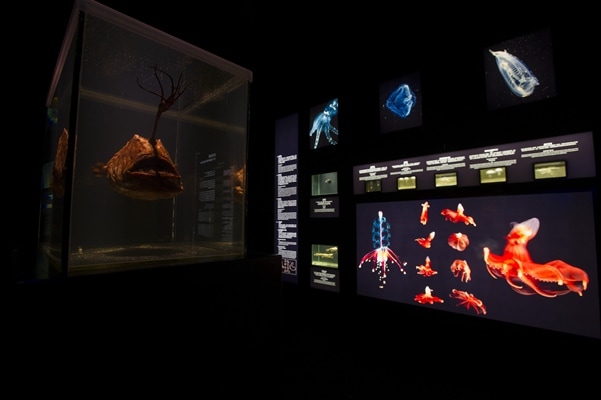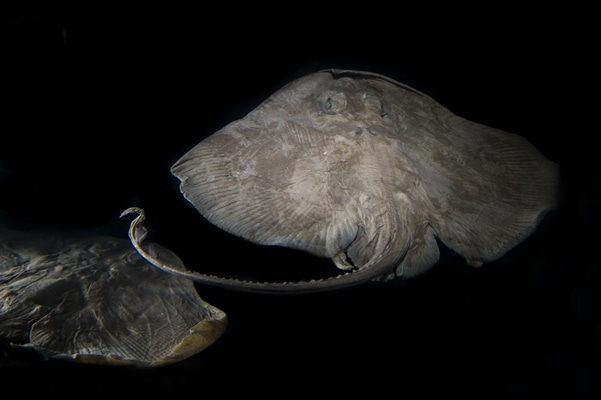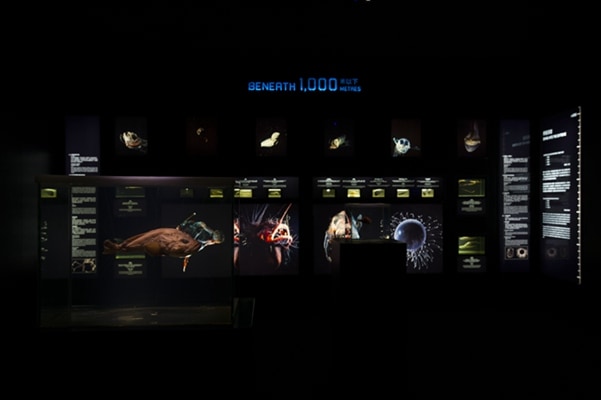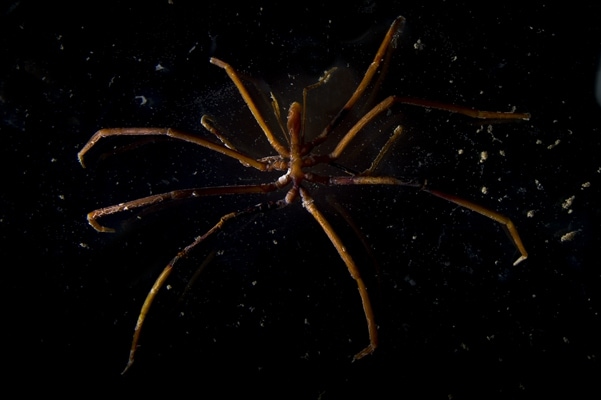The exhibition unfolds to reveal the different depth of the sea, such as life in the mid-water and life on the ocean floor through the various themed zones:
- 150m - 600m: The Twilight of the Ocean
- 600m - 1000m: The Appearance of Colour
- Beneath 1000m: Dive into the Extreme
- The Abyssal Plain: The Bottom of the Sea
- Themed Zones

150m - 600m: The Twilight of the Ocean
Light levels rapidly decrease in the oceans – at 150 meters below the surface, 99% of light has already been absorbed by seawater. This is a highly dangerous zone for the animals as they can be seen by their predators, yet it is a location where food is more abundant than the deeper levels. For some abyssal creatures, inhabitation in this treacherous region is worth the risk.
An effective strategy for escaping the predators is to pass unseen. Therefore most of the animals found in this level have bodies which light can pass through. Forming a delicate “glass menagerie”, the animals trick the predators by appearing invisible.
Most of the organisms found at this level are predominately gelatinous in nature.

600m - 1000m: The Appearance of Colour
Contrary to expectations, a new group of animals, whose colours ranging from bright red to dark brown can be found below 600m. Red is the first wavelength to disappear in the water, so it acts as a black cape, which camouflages the animals from predators.
Such pigments absorb the blue-green bioluminescence that most animals create at these depths, cloaking any bioluminescent sparks their prey might emit once in their stomachs.
The oxygen level drops progressively as distance from the surface increases. It reaches its lowest limit between 600m to 1300m. Vast majority of animals can only stay briefly in this zone.

Beneath 1000m: Dive into the Extreme
Below 1000m, total darkness reigns supreme and the temperature does not exceed 4oC. Most of the animals are static creatures with slow metabolisms, which resort to tricks to find their meals, rather than using force or speed.
The only available food sources are the crumbs falling from the shallows as the majority of which have been eaten on their way down by the other abundant organisms. The scarcity of food supply has forced animals to economize on their energy use and conserve muscle reserves.
The creatures which live in low densities in this dark kingdom have to adapt to survive in such a hostile environment. Not only do they have to look for food, there is also a need to find a mate- not an easy task in the vast darkness of the deep ocean floor.

The Abyssal Plain: The Bottom of the Sea
Once thought to be a flat and lifeless desert, the deep sea floor is now suspected to host a diversity of animal life that may exceed that of the Amazon Rain Forest and the Great Barrier Reef combined. Nearly three quarters of the deep-ocean floor is very flat and veneered by a layer of mud that can be hundreds of meters thick. Apart from bioluminescence produced by the animals themselves, the deep sea is dark- much too dark for plants to grow. The deep sea forests are built of sea anemones, corals and tubeworms.
The depths make up the greatest reservoir of life on planet. The deep-sea populations are very rich in species, but there are not great numbers of each solely because of the lack of food resources.
